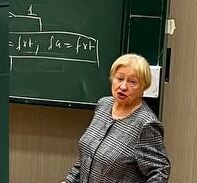ВКР - Математическая модель задержек поездов (1222229), страница 10
Текст из файла (страница 10)
Proof. We have

Observe that departure time  of the first train is
of the first train is  . Therefore, according to order of the train departures, if
. Therefore, according to order of the train departures, if  , then
, then  and, consequently,
and, consequently,  . Otherwise if
. Otherwise if  , then
, then  , i.e.
, i.e.  . Hereof we get
. Hereof we get

and thus we obtain the following equality

which is equivalent to (1.11).
Let  is fixed. We consider the random events
is fixed. We consider the random events
 (1.28)
(1.28)
Note that these events are mutually exclusive and  .
.
Notice that if, for instance, n = 3, then  , and if n = 4, then
, and if n = 4, then  , i.e. events
, i.e. events  , in general, depend on n.
, in general, depend on n.
Lemma 4. Let . The following formula holds
. The following formula holds
 (1.29)
(1.29)
Proof. Suppose for clarity that n = 6. We have
 (1.30)
(1.30)
By Theorem 1, item 1, the event entails the following equality
entails the following equality

thus,
 (1.31)
(1.31)
The event  implies that the inequality
implies that the inequality  is satisfied. Then, from (1.25), we obtain
is satisfied. Then, from (1.25), we obtain

hence
 (1.32)
(1.32)
The event  entails inequality (1.22) as follows
entails inequality (1.22) as follows

According to Theorem 1 from this inequality we deduce that  . Thus,
. Thus,
 (1.33)
(1.33)
Similarly, we obtain
 (1.34)
(1.34)
Gathering (1.30) – (1.34) we arrive at the equality
 (1.35)
(1.35)
Obviously,
 (1.36)
(1.36)
Next, since  , then
, then
 (1.37)
(1.37)
Note that  . Consequently,
. Consequently,
 (1.38)
(1.38)
From (1.35) – (1.38) we obtain
 (1.39)
(1.39)
Equality (1.39) is equivalent to (1.29). Indeed, given  the implication
the implication  holds. Therefore
holds. Therefore
 .
.
Thus,

hence

The proof in the case an arbitrary  remains unchanged. For n = 3 the proof only simplified.
remains unchanged. For n = 3 the proof only simplified.
Proof of Theorem 2. The formula (1.11) is proved in Lemma 3 and the formula (1.12) for k = 3 is proved in Lemma 4.
The proof of eqn (1.12) for  we carry out by analogy with the proof of Lemma 4.
we carry out by analogy with the proof of Lemma 4.
We have
 (1.40)
(1.40)
By Theorem 1, item 1, the event  entails the following equality
entails the following equality

hence
 (1.41)
(1.41)
If the event  occurred, then due to (1.26) the following relation holds
occurred, then due to (1.26) the following relation holds

from which we get

Likewise, for all 
 (1.42)
(1.42)
From (1.41) and (1.42), bearing in mind that

we obtain
 (1.43)
(1.43)
Furthermore, by using (1.25) and relation

we find that
 (1.44)
(1.44)
Let us assume that the event  occurred. Then inequality (1.22) holds. Hence according to (1.7) we deduce that
occurred. Then inequality (1.22) holds. Hence according to (1.7) we deduce that  . Thus,
. Thus,
 (1.45)
(1.45)
Gathering (1.40), (1.43) – (1.45) we arrive at the equality
 (1.46)
(1.46)
Arguing as at the end of the proof of Lemma 4, we obtain

Therefore

It follows that (1.46) entails (1.12).
1.4 Proof of corollaries from the theorem 2
Proof of Corollary 2. Let  . Taking into account (1.13), we denote
. Taking into account (1.13), we denote
 (1.47)
(1.47)
From Corollary 1 and (1.12) it follows that for 
 (1.48)
(1.48)
where

We have
 (1.49)
(1.49)
and
 (1.50)
(1.50)
Taking into account the continuity of random variable  , from (1.48) – (1.50) we obtain (1.14).
, from (1.48) – (1.50) we obtain (1.14).
Proof of Corollary 3. When we replace in (1.14)  with T, we obtain eqn (1.15).
with T, we obtain eqn (1.15).
Proof of Corollary 4. It is well-known, that if  and
and  are two independent random variables, and besides
are two independent random variables, and besides  has the density function
has the density function  , then for any measurable function
, then for any measurable function  of two variables и and for each
of two variables и and for each 
 (1.51)
(1.51)
Formula (1.51) entails the following form of  :
:
 (1.52)
(1.52)
Formulas (1.11) and (1.52) lead to (1.17).
Let  . Consider the formula (1.12). We use the notation (1.47). Note that
. Consider the formula (1.12). We use the notation (1.47). Note that
 ,
,  and
and  are mutually independent,
are mutually independent,  has the density function
has the density function  . Therefore
. Therefore
 (1.53)
(1.53)
Next, similarly to (1.51), we get
 (1.54)
(1.54)
In turn,

Consequently,
 (1.55)
(1.55)
From (1.54) and (1.55) we obtain
 (1.56)
(1.56)
According to (1.12), the relations (1.53) and (1.56) are to be added. As a result, we arrive at (1.18).
1.5 Proof of Lemma 1
We use the events, similar to (1.28). It is easy to see that

Hence

1.6 The case when the time intervals Tj are constants
Lemma 5. Let all Tj be constants and be equal to some  . If
. If
 (1.57)
(1.57)
with  , then for
, then for 
 (1.58)
(1.58)
Moreover,
 (1.59)
(1.59)
 (1.60)
(1.60)
Proof. We use the result of Corollary 3. From (1.57) it follows that
 (1.61)
(1.61)
Using this equation, the formula (1.58) for k = 2 is obtained from (1.16), а for  it is obtained from (1.15).
it is obtained from (1.15).
Let us calculate the mean and variance of the random variables  . Since
. Since

then  has one point of discontinuity
has one point of discontinuity  , and
, and  ,
,  , has two points of discontinuity
, has two points of discontinuity  and
and  (see Figure 1.3). Moreover, for
(see Figure 1.3). Moreover, for 

Therefore, for every bounded continuous function  , we have
, we have
 (1.62)
(1.62)
 . It is easily seen that (1.62) is also true when k = 2. Using well known equations
. It is easily seen that (1.62) is also true when k = 2. Using well known equations

then, for  we obtain
we obtain
 (1.63)
(1.63)
 (1.64)
(1.64)
From (1.62) and (1.63) it follows that

This proves formula (1.59).
In turn, from (1.62) and (1.64) the following relation implies

Consequently,
 (1.65)
(1.65)
Transforming the right hand side of (1.65), we arrive at (1.60).
Figure 1.3 shows the graphs of functions  from (1.58) with k = 2, 3 and the parameters
from (1.58) with k = 2, 3 and the parameters
 (1.66)
(1.66)
Figure 1.3 – The behavior of functions  and
and 
With the aid of equations (1.59) and (1.60) we get with precision to 

Remark 3. It is easily seen that the greater k, the function  from (1.58) is closer to
from (1.58) is closer to  . This is consistent with Figure 1.3, and formulas (1.59) and (1.60), whereby
. This is consistent with Figure 1.3, and formulas (1.59) and (1.60), whereby  ,
,  when
when  .
.
Remark 4. If maximum probability p that occurs at least m of secondary delays is given, and  has the density function (1.57), then by Corollary 5 the parameter T satisfies the following condition
has the density function (1.57), then by Corollary 5 the parameter T satisfies the following condition
 (1.67)
(1.67)
(see also [6]). We denote by  the minimum T, that satisfies to the inequality (1.67). Consider the following example. Let
the minimum T, that satisfies to the inequality (1.67). Consider the following example. Let  . Figure 1.4 shows the behavior of
. Figure 1.4 shows the behavior of  as a function of a continuous parameter m when p = 0.1 and
as a function of a continuous parameter m when p = 0.1 and
p = 0.05. It is clear that with a decrease of p the value of  increases. Exact calculations can be performed according to the following formula
increases. Exact calculations can be performed according to the following formula
 (1.68)
(1.68)
Figure 1.4 – The behavior of  when p = 0.1 and p = 0.05
when p = 0.1 and p = 0.05
Now we fix p = 0.1. Figure 1.5 shows the behavior of  as a function of a continuous parameter m for
as a function of a continuous parameter m for  and
and  . In accordance with equation (1.68) the value
. In accordance with equation (1.68) the value  increases, when
increases, when  decreases. Since random variable
decreases. Since random variable  is exponentially distributed and the equality
is exponentially distributed and the equality  holds, then the reduction of
holds, then the reduction of  leads to an increase in the mean value of primary delay, which in turn leads to an increase in the intervals between trains (if we want to reduce the number of secondary delays).
leads to an increase in the mean value of primary delay, which in turn leads to an increase in the intervals between trains (if we want to reduce the number of secondary delays).
Figure 1.5 – The behavior of  when
when  and
and 
All parameters, which we use in this example, are valid for the main railway sites (directions) of Russian railways.
The calculation shows that additional (to the value of T) interval is equal to 4.5 minutes for m = 2. Total duration of the minimum interval between trains is 9.5 minutes. It should be noted that the headway of heavy freight trains at the Russian railways lies in the range from 10 to 14 minutes. Obviously, this decision is due to the need to obtain a small amount of unplanned delays. Indeed, when mknock is equal to 1, the interval, which is calculated by our technique, represents 13 minutes.
1.7 The case when the time intervals Tj have the normal distribution
Let us define
 (1.69)
(1.69)
where  , T and
, T and  are some positive parameters. Mark that since random intervals Tj cannot be negative numbers, the assumption of a density function
are some positive parameters. Mark that since random intervals Tj cannot be negative numbers, the assumption of a density function  in (1.69) is incorrect. However, by choosing the parameter
in (1.69) is incorrect. However, by choosing the parameter  (when T is known), we can ensure that the probability of the event
(when T is known), we can ensure that the probability of the event  was closer to 0. We assume that
was closer to 0. We assume that
 . (1.70)
. (1.70)
We consider the standard normal random variable Y. Its distribution function is equal to
 .
.
From (1.70), in particular, it follows that  . Then
. Then
 .
.
Note that the choice of the density function  from (1.69) is caused by the following property: for any integer
from (1.69) is caused by the following property: for any integer  the following equality holds
the following equality holds
 . (1.71)
. (1.71)
Also, when  , we denote
, we denote
 .
.
Lemma 6. Suppose that all Tj are independent identically distributed random variables. If the density functions g and  are defined in (1.69), then
are defined in (1.69), then
 (1.72)
(1.72)
 (1.73)
(1.73)
Moreover,
 (1.74)
(1.74)
 (1.75)
(1.75)
 (1.76)
(1.76)
 (1.77)
(1.77)
Proof. We use the result of Corollary 4. According to (1.17) we get
 .
.
Thus
 , (1.78)
, (1.78)
where
 .
.
Let Y be standard normal random variable. Then
 . (1.79)
. (1.79)
Let us calculate J2. It is easy to check that for any  and
and 
 ,
,
whence
![]() . (1.80)
. (1.80)
Consequently,
 , (1.81)
, (1.81)
where
 .
.
Thus, for any 
 (1.82)
(1.82)
From (1.82) it follows that
 (1.83)
(1.83)
Equation (1.72) follows from (1.17), (1.78), (1.79) and (1.83).



















